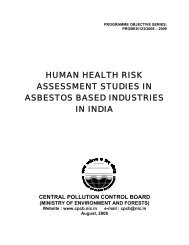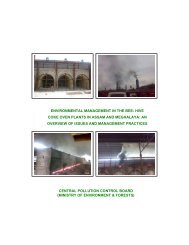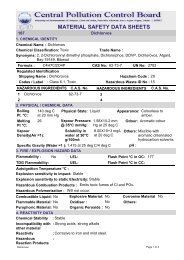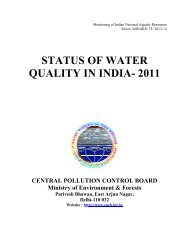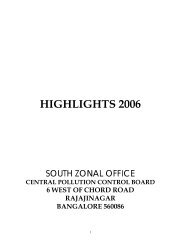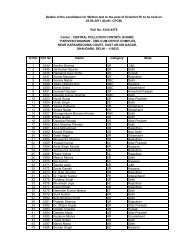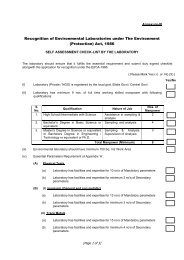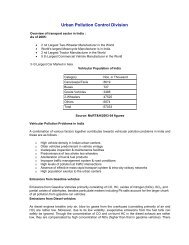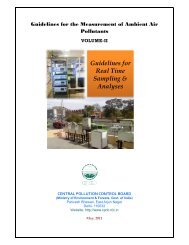MATERIAL SAFETY DATA SHEETS
MATERIAL SAFETY DATA SHEETS
MATERIAL SAFETY DATA SHEETS
You also want an ePaper? Increase the reach of your titles
YUMPU automatically turns print PDFs into web optimized ePapers that Google loves.
<strong>MATERIAL</strong> <strong>SAFETY</strong> <strong>DATA</strong> <strong>SHEETS</strong><br />
Sodium fluoroacetate<br />
570<br />
1. CHEMICAL IDENTITY<br />
Chemical Name : Sodium fluoroacetate<br />
Chemical Classification: Toxic<br />
Trade Name :<br />
Synonyms: SFA, Sodium monofluoroacetate, Fluoroacetic acid sodium salt<br />
Formula : C2H2FNaO2<br />
CAS No: 62-74-8 UN No: 2629<br />
Regulated Identification<br />
Shipping Name :<br />
Hazchem Code : 2X<br />
Codes / Label : Class 6.1, Toxic<br />
Hazardous Waste ID No :<br />
HAZARDOUS INGREDIENTS C.A.S. No. HAZARDOUS INGREDIENTS C.A.S. No.<br />
1 Sodium fluoroacetate 62-74-8 3<br />
2<br />
4<br />
2. PHYSICAL / CHEMICAL <strong>DATA</strong><br />
Boiling<br />
Physical State: Solid. Appearance: A fine, white,<br />
Pt. °C:<br />
powdered solid.<br />
Melting 200-202 Vapour Pressure Approx 0.0 mm Odour: Odourless<br />
Pt °C: decomposes @ 35°C mmHg: Hg at 20 deg C<br />
Vapour<br />
Solubility in 1110 g/L at 25 Others:<br />
Density(Air =1):<br />
water at 30°C<br />
g/100ml:<br />
deg C<br />
Specific Gravity (Water =1 ):<br />
3. FIRE / EXPLOSION HAZARD <strong>DATA</strong><br />
pH :<br />
Flammability :<br />
LEL:<br />
Flash Point °C in OC:<br />
TDG Flammability:<br />
Autoignition Temperature °C :<br />
UEL:<br />
Flash Point °C in CC:<br />
Explosion sensitivity to impact:<br />
Explosion sensitivity to static Electricity:<br />
Hazardous Combustion Products : Fire may produce irritating, corrosive and/or toxic gases.<br />
Hazardous Polymerization :<br />
Combustible Liquid: Explosive Material:<br />
Corrosive Material<br />
Flammable Material: Oxidiser :<br />
Others:<br />
Pyrophoric Material:<br />
4. REACTIVITY <strong>DATA</strong><br />
Organic Peroxide :<br />
Chemical Stability : Stable<br />
Incompatibility with :<br />
other material<br />
Reactivity<br />
: Reacts as bases to neutralize acids.<br />
Hazardous<br />
Reaction Products<br />
: Decomposition at 200 deg C.<br />
5. HEALTH HAZARD <strong>DATA</strong><br />
Sodium fluoroacetate<br />
Page 1 of 3
Routes of entry: Inhalation, Ingestion, Skin and Eyes<br />
Effects of Exposure / Symptoms:<br />
Inhalation : Respiratory depression and pulmonary edema have been reported. Ingestion :<br />
Nausea, vomiting, excessive salivation and diarrhea may be noted. Skin : Avoid any skin<br />
contact.<br />
occur.<br />
Eye : Numbness of the face and facial twitching, blurred vision and nystagmus may<br />
Emergency Treatment :<br />
Inhalation: Move patient to fresh air. Monitor for respiratory distress. Administer oxygen and<br />
assist ventilation as required. Treat bronchospasm with beta2 agonist and<br />
corticosteroid aerosols.<br />
Skin: Remove contaminated clothing and wash exposed area thoroughly with soap and<br />
water. A physician should examine the area if irritation or pain persists.<br />
Eyes: Irrigate exposed eyes with copious amounts of tepid water for at least 15 minutes. If<br />
irritation, pain, swelling, lacrimation, or photophobia persist, the patient should be<br />
seen in a health care facility.<br />
Ingestion: Do not induce emesis. Activated charcoal: administer charcoal as a slurry (240 ml<br />
water/30 g charcoal). Usual dose: 25 to 100 g in adults/adolescents.<br />
LD50 (oral-rat) mg/kg:<br />
LC50 (rat) mg/kg:<br />
0.1 mg/liter/10<br />
minutes (Guinea pig)<br />
STEL: 0.15 mg/m3 (skin)<br />
Odour Threshold:<br />
Permissible<br />
Exposure Limit:<br />
0.05 mg/m3, skin TLV (ACGIH) : 0.05 mg/m3, skin<br />
NFPA Hazard<br />
Health Flammability Reactivity Special<br />
Signals<br />
0 0<br />
6. PREVENTIVE MEASURES<br />
Personal Protective : Wear appropriate eye protection and protective clothing to prevent skin<br />
Equipment<br />
and eye contact. Facilities for quickly drenching the body should be<br />
provided within the immediate work area for emergency use where there<br />
is a possibility of exposure.<br />
Handling<br />
: All chemicals should be considered hazardous. Avoid direct physical<br />
contact. Use appropriate, approved safety equipment. Untrained<br />
individuals should not handle this chemical or its container. Handling<br />
should occur in a chemical fume hood.<br />
Storage : Keep in a cool, dry, dark location in a tightly sealed container or<br />
cylinder. Keep away from incompatible materials, ignition sources and<br />
untrained individuals. Secure and label area. Protect<br />
containers/cylinders from physical damage.<br />
Precautions :<br />
7. EMERGENCY / FIRST AID MEASURES<br />
FIRE:<br />
Fire Extinguishing Media :<br />
Special Procedure :<br />
Unusual Hazards : When heated to decomposition, it emits highly toxic fumes of<br />
sodium oxide and fluorides.<br />
EXPOSURE: First Aid Measures:<br />
Inhalation: Move patient to fresh air. Monitor for respiratory distress. Administer oxygen and<br />
assist ventilation as required. Treat bronchospasm with beta2 agonist and<br />
Sodium fluoroacetate<br />
Page 2 of 3
Skin:<br />
Eyes:<br />
Ingestion:<br />
corticosteroid aerosols.<br />
Remove contaminated clothing and wash exposed area thoroughly with soap and<br />
water. A physician should examine the area if irritation or pain persists.<br />
Irrigate exposed eyes with copious amounts of tepid water for at least 15 minutes. If<br />
irritation, pain, swelling, lacrimation, or photophobia persist, the patient should be<br />
seen in a health care facility.<br />
Do not induce emesis. Activated charcoal: administer charcoal as a slurry (240 ml<br />
water/30 g charcoal). Usual dose: 25 to 100 g in adults/adolescents.<br />
Antidotes / Dosages:<br />
SPILLS :<br />
Steps To Be Taken : Keep sparks, flames, and other sources of ignition away. Keep<br />
material out of water sources and sewers.<br />
Waste Disposal Method:<br />
8. ADDITIONAL INFORMATION / REFERENCES<br />
9. MANUFACTURERS / SUPPLIERS <strong>DATA</strong><br />
NAME OF FIRM :<br />
Contact person<br />
MAILING ADDRESS :<br />
in Emergency :<br />
TELEPHONE / TELEX NOS :<br />
Local Bodies involved :<br />
TELEGRAPHIC ADDRESS :<br />
Standard Packing :<br />
OTHERS :<br />
Trem Card Details / Ref :<br />
10. DISCLAIMER<br />
Information contained in this material data sheet is believed to be reliable but no representation,<br />
guarantee or warranties of any kind are made as to its accuracy, suitability for a particular<br />
application or results to be obtained from them. It is up to the manufacturer/ seller to ensure that<br />
the information contained in the material safety data sheet is relevant to the product<br />
manufactured / handled or sold by him as the case may be. The Government makes no<br />
warranties expressed or implied in the respect of the adequacy of this document for any<br />
particular purpose.<br />
End of document<br />
Total No. of Pages: 3<br />
Sodium fluoroacetate<br />
Page 3 of 3



